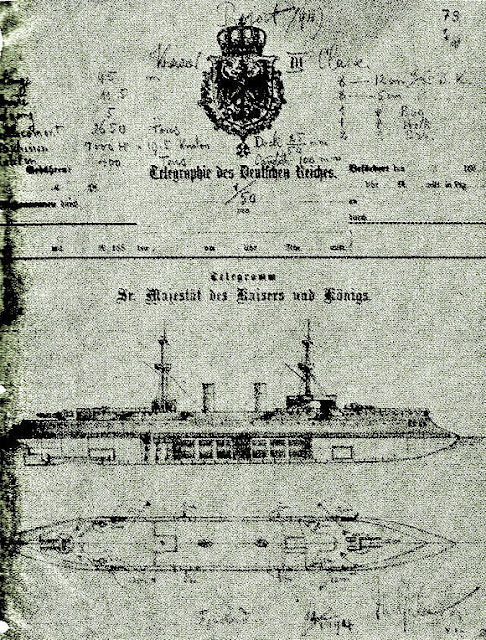 |
| A Happy-Looking Kaiser Wilhelm Aboard a Navy Ship |
I had a peculiar passion for the navy. It sprang to no small extent from my English blood. When I was a little boy...I admired the proud British ships. There awoke in me the will to build ships of my own like these someday, and when I was grown up to possess a fine navy as the English.
Kaiser Wilhelm II, My Early Life
In the extra-large fantasy compartment of Kaiser Wilhelm's brain, he could muse over a fleet so magnificent and elegant his British cousins would turn emerald green with envy at the semi-annual naval review while doing their gentlemanly best to hide their crushed self-importance behind stiff upper lips. I doubt, though, that he ever imagined that they would view his naval build-up as a threat to their national survival. Oddly, when the British Admiralty responded determinedly with its own building program and innovative ship design, that didn't seem to puncture the illusions of the Kaiser or his expert, Admiral Tirpitz, whose grandiosity reminds me a bit of a building-czar Robert Moses. They kept building until they ran out of money.
A recent thesis by Wesley R. Hale at the University of Rhode Island nicely summarizes how Kaiser Wilhelm II was inspired (seduced?) into building his huge, but eventually inadequate and doomed, battle fleet.
At the beginning of the 20th century, England possessed the largest navy in the world, having established in 1889 a Naval Defense Act that formalized the "Two Power Standard" of parity with the next two naval powers, France and Russia." Kaiser Wilhelm II sought to earn prestige as a monarch by elevating Germany to a maritime power in the same manner his grandfather Wilhelm I had transformed the Prussian Army to unify Germany under one flag. Unlike his grandfather, whose reorganization efforts benefited from a long history of military institution, where the Prussian army was a fixture of society, Wilhelm II faced the challenge of developing a formidable navy in a country lacking a cohesive naval tradition.
 |
| An 1894 Cruiser Design by Kaiser Wilhelm II |
Kaiser Wilhelm and his admirals envisioned [a battle fleet] elevating Germany to a maritime power in line with A.T. Mahan's notion of military strength. First published in 1890, Mahan's book The Influence of Sea Power Upon History, 1660-1783 argued that numerical superiority accounted for much of the maritime success of the major world powers against their enemies. While he highlighted several naval battles throughout history, Nelson's victories at the Battle of the Nile and Trafalgar were both particularly important to this argument and still relatively recent history. To that end, Mahan begins his introduction with a discussion of the basic tactics of those battles, which were "to choose that part of the enemy's order which can least easily be helped, and to attack it with superior forces." Mahan's work became one of the most influential geopolitical pieces of its time, eventually becoming recommended reading for every major world leader with global ambitions, including Theodore Roosevelt and Wilhelm II. His book became a manual that set the naval standard to which all major powers subscribed and to which Imperial Germany aspired.
Over the next half-decade, Wilhelm—being Wilhelm—fantasized, talked, consulted industrialists, pressured ministers, and gave endless pep talks to his family and entourage about the necessity for a world-class German fleet. As the illustration above shows, he was even designing his own ships. His motto was "The Trident Must Be in Our Fist." However, when he made that assertion, Wilhelm's "trident" consisted of a navy of only 68 ships, compared to the Royal Navy's 330.
 |
| The Four Battleships of the Brandenburg-Class Were the First Seaworthy German Capital Ships |
. . . The German ruling elite after 1895 also seemed convinced of the need for large-scale territorial expansion when the time was ripe, with Admiral Tirpitz arguing that Germany's industrialization and overseas conquests were "as irresistible as a natural law"; with Chancellor Bülow declaring, "The question is not whether we want to colonize or not, but that we must colonize, whether we want it or not.": and with Kaiser Wilhelm himself airily announcing that Germany "had great tasks to accomplish outside the boundaries of old Europe. . .
What was significant about German expansion was that the country either already possessed the instruments of power to alter the status quo or had the material resources to create such instruments. The most impressive demonstration of this capacity was the rapid buildup of the German navy after 1898, which under Tirpitz was transformed from being the sixth-largest fleet in the world to being second only to the Royal Navy.

No comments:
Post a Comment